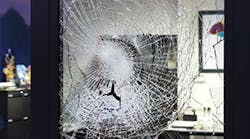Glass windows may let in welcomed daylight, but all it takes is a determined intruder and your property could be breached with a single blow. Even if the window is alarmed, an intruder often has 10-15 minutes before help arrives – plenty of time to do considerable damage.
“If someone can gain entry through a window undetected, they could move product, vandalize your property, or threaten human life without ever opening a door,” explains Tom Connaughton, global director of life safety and security services for Intertek, a third-party product testing and certification body.
When used as another security layer, however, windows can protect your property. Learn about these five reinforcement strategies that will ensure your windows are part of the security solution.
1) Contacts and Sensors
If your windows are at risk of being forced open, install a contact alarm. Similar to those used on doors, this device will send an alert when contact has been broken, Connaughton says. These devices, however, can’t detect if the window is broken as opposed to opened.
Use glass break sensors instead, which are set to trigger at the sound of breaking glass. Where cost-effective, use both technologies together for optimal protection.
2) Passive Infrared
Video can be a valuable resource for window security and is used in the same way as for entrance monitoring, Connaughton recommends. For example, you can aim infrared cameras at high-risk windows. Whenever motion is detected, the unit will start recording or transmitting to a central monitoring station. Depending on your system, either an alert or live feed will be sent to your security team.
You can also sync sensors on the windows themselves with the camera; when triggered by the window being broken or opened, the camera will activate. Either configuration will allow security to verify the threat and weed out false alarms. PageBreak
3) Safety and Privacy Films
Expansive windows have become a more popular choice with the rising emphasis on daylighting.
“Yet it also allows someone with questionable motives to clearly see who is in a building and which areas might be most vulnerable to entry,” says Darrell Smith, executive director for the International Window Film Association.
To protect occupants and interiors from flying glass shards, you can also install safety films, which “controls the post-failure behavior of glass fragments,” recommends Smith.
Note that none of these film or glass options are shatter-proof, but the extra resistance they afford may discourage or delay intruders. Privacy tinting, blinds, and shades can also be used to obstruct views into your building.
Window films are easy to retrofit and can be installed with minimal disruption. Costs for a basic safety film range from $4-6 per square foot and security films average between $12-25 per square foot, says Smith.
“Another way to justify costs is to combine the properties of an energy control window film with the safety version,” he adds. “In many cases, the energy savings will not only pay for themselves, but also pay for the security benefits.”
For facilities facing terrorism or active shooter risks, security glass can address blast or bullet impacts.
4) Metal Barriers
Wire mesh around a window or a cage can be an effective deterrent if it’s deployed properly, cautions Connaughton, though some owners may have reservations about aesthetic concerns. Mesh placed on only the exterior can be removed with ease or even compromised over a period of time.
If the mesh is installed on the inside, the glass can still be broken but the alarm will ensure intruders have a limited amount of time to defeat the mesh, gain entry, carry out their task, and leave undetected.
Don’t forget about the path of fire egress with any window barriers, Connaughton stresses. As much as you need windows to deter people from entering, they must also be used in emergencies to exit. Make sure any features include an internal release mechanism for safe removal.
5) Perimeter Detection
Think like a criminal and scope your own building – what can you learn about occupancy patterns and potential targets just by looking through your windows? What can you easily see that would be tempting to steal or vandalize?
Not only can you increase good security practices, such as setting merchandise or computer equipment back from windows, but you should also review the effectiveness of your other perimeter security measures.
“Windows are really a last line of defense,” says Connaughton. “There should be other deterrents to foil someone from reaching the windows in the first place.”
As you weigh the costs of these different solutions, it’s best to make investments based on risk mitigation.
Set goals such as reductions in property damage, vandalism occurrences, or number of break-ins to help justify the improvements required to make your windows more secure.
Jennie Morton [email protected] is associate editor of BUILDINGS.


